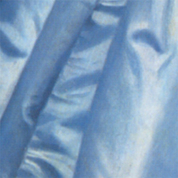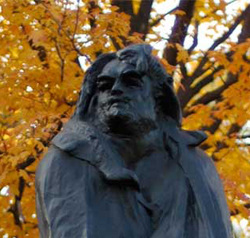Each choice an artist makes about his/her work communicates something to you, the viewer. For you to speak and write intelligently about art, you need to understand and be able to utilize the vocabulary of art.
The following terms and definitions are fundamental to your understanding a work of art. They will help you apply words to your visual experience and will make you a more credible and respected artist and historian.
The following terms and definitions are fundamental to your understanding a work of art. They will help you apply words to your visual experience and will make you a more credible and respected artist and historian.
Medium - the physical material or techniques that an artist uses to create their work.
• What is the work made out of?
• What is the work made out of?
Alexander Calder, Tom's, 1974 Aubrey Beardsley, detail from Charles and Ray Eames, Lounge Joan Mitchell, Ici, 1974
steel plate, bolts and paint The Climax, 1893, ink on paper Chair, 1945, bent plywood oil on canvas
steel plate, bolts and paint The Climax, 1893, ink on paper Chair, 1945, bent plywood oil on canvas
|
Subject Matter - the identifiable objects or ideas represented in a work.
• What do you see in this work of art? In this example, a skull, shell, book, and other objects are present. Content - what a work means; this is not always evident by looking at the work, sometimes takes research. The work's Title can also give clues to the meaning. • Is there a deeper meaning in the work, beyond what I can see? This is an example of a vanitas painting typical of the Northern Renaissance. The painting, created in 1640 by Harmen Steenwyck, is titled "Still Life: An Allegory of the Vanities of Human Life." This style of painting was popular in religious and austere northern Europe as it is meant to represent the fleeting nature of life and its follies. A work of art often has an obvious meaning or interpretation but it may also have an allegorical meaning that is not immediately obvious. |
Harmen Steenwyck, Still Life: An Allegory of the Vanities
of Human Life, 1640 |
|
Iconography - "image or symbol writing" - the use of one object to represent something else.
Overt Iconography is easily understood and fairly obvious Hidden Iconography usually requires an understanding of the artist/time period/politics/society • Does anything stand for something else in this work? The National Gallery in London houses this painting, and describes the work: |
"The books symbolize human knowledge, the musical instruments (a recorder, part of a shawm, a lute) the pleasures of the senses. The
Japanese sword and the shell, both collectors' rarities, symbolize wealth. The chronometer (detail above left) and expiring lamp allude to the
transience and frailty of human life. All are dominated by the skull, the symbol of death." The skull is probably an example of overt iconography
as most viewers would correlate this with death, but the other objects require some research to understand their presence in the painting.
Japanese sword and the shell, both collectors' rarities, symbolize wealth. The chronometer (detail above left) and expiring lamp allude to the
transience and frailty of human life. All are dominated by the skull, the symbol of death." The skull is probably an example of overt iconography
as most viewers would correlate this with death, but the other objects require some research to understand their presence in the painting.
Hue - the name of the color (red, blue, green, etc.) Color Schemes are planned groupings of hues.
• The different hues here create different color schemes.
• The different hues here create different color schemes.
Monet, Grainstacks in the Sunlight Monet, Haystacks (Midday), Monet, Wheatstacks (Sunset,
(Morning Effect), 1890 1890-91 Snow Effect), 1890-91
(Morning Effect), 1890 1890-91 Snow Effect), 1890-91
|
Saturation - how bright or dull the colors are.
• Which of these works has brighter, more intense colors? Its colors are more saturated. Piet Mondrian, Composition Piet Mondrian, Composition
with Large Blue Plane, Red, with Color Planes and Black, Yellow, and Gray, 1921 Gray Lines 1, 1918 |
Value - the amount of light or dark.
• The grayscale is a visual way to represent the entire range of values from light (white) to dark (black). Rembrandt, Night Watch, 1642
|
Line - a mark made by a moving point, lines can create patterns, move the eye through a composition, and describe emotions.
• Contour Lines define the outside edges of shapes, like a cartoon outline
• Calligraphic Lines are made by using value (light and dark) and shading
Jasper Johns, Scent, 1973-74 Roy Lichtenstein, In The Car, 1963 Bernini, Bust of Costanza Bonarelli, 1636-37
Contour Lines Calligraphic Lines
Contour Lines Calligraphic Lines
Texture - refers to the tactile (touch) aspects of art.
Actual Texture is how the artwork would feel if you could touch it; this is strongly influenced by the media used to create the work.
• If I ran my hand across the canvas, how would it feel?
Implied Texture is the illusion of texture.
• You can't actually touch implied texture, it is created visually.
• If I ran my hand across the canvas, how would it feel?
Implied Texture is the illusion of texture.
• You can't actually touch implied texture, it is created visually.
|
Shape - an area that stands out from the space next to or around it because of line, color, value, or texture.
|
Actual shapes can be seen clearly and immediately by the eye.
• What "things" are different from their surroundings? Raphael's painting contains three figures that are clearly seen as distinct from their surroundings. These figures, along with the tree in the left and the church in the far right, are actual shapes. Implied shapes are ways of arranging the elements in a composition. • What arrangement do these shapes have on the page? Within the painting Raphael has arranged his figures in a triangular composition, a common effect used to reference the holy trinity. This creates an implied shape. |
|
Space - either the 2D or 3D aspects of the work.
• In design, space gives a 2D (flat) object the 3D illusion of depth.
|
Perspective - a technique used to show the illusion of depth, to
create visual space.
Gustav Caillebotte, Le Pont de l'Europe, 1876
|
Foreshortening - distorting an object to make it appear to recede
in space.
Linear Perspective - all lines and edges appear to vanish at the same point in the distance. Edward Ruscha, Standard Station, 1966
|
Balance - the distribution of visual weight in a work of art.
|
Symmetry -
when a work is even (balanced) on the left and right sides.
Arne Jacobsen, Swan Model
3320, 1957
|
|
Unity - a sense of oneness, that different elements belong together. This is
created by the repetition of shapes, colors, textures, linear directions, etc.
• What is the same about this piece of art? Variety - provides interest and vitality, eliminates boredom. • What is different about this piece of art? |
Andy Warhol, Che Guevara, 1962
|
|
Movement - the visual flow of a work. This has a psychological effect on the viewer and can enhance your message in subtle ways.
• Does this work appear to flow in any particular direction?
|
Figure/Ground - We see a mark on a page (figure) as distinct from is background (ground) • Figure is also called Positive Space • Ground is also called Negative Space NEAR RIGHT: Geoffroy Troy, Capital from a Series of Initials, 1526 FAR RIGHT: Kasimir Malevich, Complex Presentiment: Half-Figure in a Yellow Shirt, 1928-32 |







































